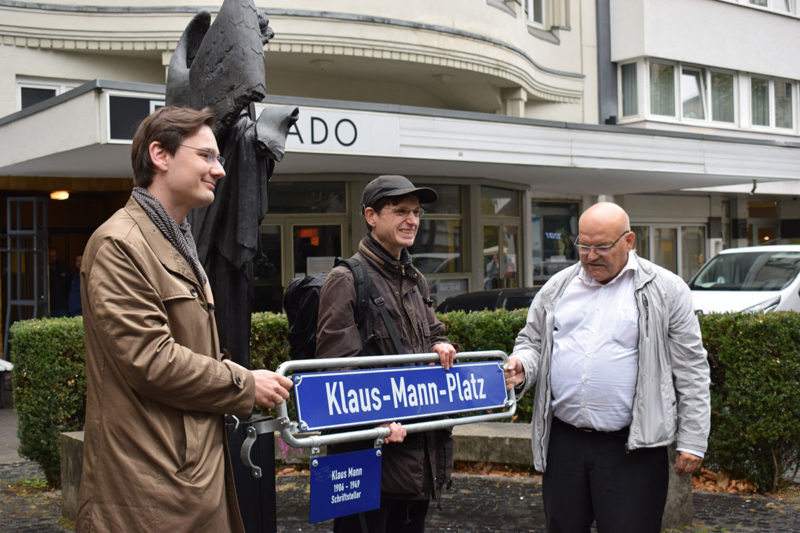On October 6th I’m in Frankfurt again for a local appointment: to receive the street signs from Klaus-Mann-Platz, which will be part of the monument to the Mann family in Munich.
The square has changed since my last visit in February 2019: The most striking features are the two black umbrellas and the benches, which indicate the extension of the restaurant to the outside area. Clearly, public space, a square is now, in Corona times, more in demand than ever. The black umbrellas with the inscription „Black“ are a bizarre match for Rosemarie Trockel’s black angel and its wingtips.

A graffiti is now emblazoned on the wall next to the street lamp with the sign, the green bin on it has been replaced by a new blue one. And the sign „Klaus-Mann-Platz“ and the holder also look new, probably a result of my enquiry …
What I didn’t expect: The handing over of the sign with a press date results in an early opening, a preview of the monument. Many of those involved in the project gather on the square: Jessica Beebone from the Department of Visual Arts of the City of Frankfurt, responsible for Public Art, Julius Reinsberg representing Ina Hartwig, Director of the Department of Culture. His speech is a good summary of Klaus Mann’s relationship to the square and monument for the persecuted homosexuals, called „Frankfurt Angel“. He also mentions Thomas and Golo Mann and their connection to Frankfurt. You can read it here.
As the monument project creates an interface between art and traffic, representatives of both departments are present: City Councilor Klaus Oesterling, who heads the Department of Transport, Michaela Kraft from the Department of Road Construction and Development, Christian Wachter from their Communications Department, Rüdiger Auth, who had a new street sign made to replace the one to be handed over. He also brought along an employe with a ladder, to unscrew the sign. Such a sign is well suited to represent multiple participation, you can touch it from several sides.



I am delighted to get my hands on an object again, something tangible, to be able to do something with it. I say the same to a journalist – although her question „what should happen to the sign?“ is more aimed at the long-term performance of the sign, at how/where it should one day find its place in the monument in Munich.
I take the sign and the rather heavy frame under my arm and start walking. The press kit with the letterhead of the city of Frankfurt proves to be helpful, as I am actually stopped by the police on my way to the underground station Konstablerwache and asked about the sign – where did it come from, and whether there is still one hanging in the square? Walking with the sign under my arm has a performative character.

In the ICE. The sign rests in the seat, in the cushion, and it fits well that it says „Platz“ instead of „Klaus-Mann-Street“. Because „Platz“ does not only denote a certain, delimited area in the open air, in public space, but also the personal place where someone is sitting, like here on the train – in English it would take a whole series of words, „square“, „space“, „room“, „place“, „seat“, „desk“ … to cover the field of meaning. And as Klaus Mann rides along beside me and I review the transaction today, I have the feeling that the handover in Frankfurt was like „the right Man(n) in the right place“.
